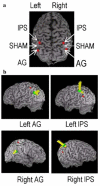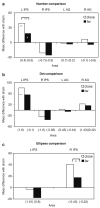rTMS over the intraparietal sulcus disrupts numerosity processing
- PMID: 17216413
- PMCID: PMC2567820
- DOI: 10.1007/s00221-006-0820-0
rTMS over the intraparietal sulcus disrupts numerosity processing
Abstract
It has been widely argued that the intraparietal sulcus (IPS) is involved in tasks that evoke representations of numerical magnitude, among other cognitive functions. However, the causal role of this parietal region in processing symbolic and non-symbolic numerosity has not been established. The current study used repetitive Transcranial Magnetic Stimulation (rTMS) to the left and right IPS to investigate the effects of temporary deactivations of these regions on the capacity to represent symbolic (Arabic numbers) and non-symbolic (arrays of dots) numerosities. We found that comparisons of both symbolic and non-symbolic numerosities were impaired after rTMS to the left IPS but enhanced by rTMS to the right IPS. A signature effect of numerical distance was also found: greater impairment (or lesser facilitation) when comparing numerosities of similar magnitude. The reverse pattern of impairment and enhancement was found in a control task that required judging an analogue stimulus property (ellipse orientation) but no numerosity judgements. No rTMS effects for the numerosity tasks were found when stimulating an area adjacent but distinct from the IPS, the left and right angular gyrus. These data suggest that left IPS is critical for processing symbolic and non-symbolic numerosity; this processing may thus depend on common neural mechanisms, which are distinct from mechanisms supporting the processing of analogue stimulus properties.
Figures



Similar articles
-
Left parietal TMS disturbs priming between symbolic and non-symbolic number representations.Neuropsychologia. 2013 Jul;51(8):1528-33. doi: 10.1016/j.neuropsychologia.2013.05.001. Epub 2013 May 9. Neuropsychologia. 2013. PMID: 23665379
-
Dissociation of numerosity and duration processing in the left intraparietal sulcus: a transcranial magnetic stimulation study.Cortex. 2008 Apr;44(4):462-9. doi: 10.1016/j.cortex.2007.08.011. Epub 2007 Dec 23. Cortex. 2008. PMID: 18387579
-
Contribution of the right intraparietal sulcus to numerosity and length processing: an fMRI-guided TMS study.Cortex. 2012 May;48(5):623-9. doi: 10.1016/j.cortex.2011.05.019. Epub 2011 Jun 1. Cortex. 2012. PMID: 21722888
-
The number domain- can we count on parietal cortex?Neuron. 2004 Oct 28;44(3):407-9. doi: 10.1016/j.neuron.2004.10.020. Neuron. 2004. PMID: 15504322 Review.
-
Bilateral Intraparietal Activation for Number Tasks in Studies Using Adaptation Paradigm: A Meta-analysis.Neuroscience. 2022 May 10;490:296-308. doi: 10.1016/j.neuroscience.2022.02.024. Epub 2022 Mar 9. Neuroscience. 2022. PMID: 35276305 Review.
Cited by
-
Representations within the Intraparietal Sulcus Distinguish Numerical Tasks and Formats.J Cogn Neurosci. 2023 Feb 1;35(2):226-240. doi: 10.1162/jocn_a_01933. J Cogn Neurosci. 2023. PMID: 36306247 Free PMC article.
-
Brief non-symbolic, approximate number practice enhances subsequent exact symbolic arithmetic in children.Cognition. 2014 Apr;131(1):92-107. doi: 10.1016/j.cognition.2013.12.007. Epub 2014 Jan 22. Cognition. 2014. PMID: 24462713 Free PMC article.
-
The angular gyrus: multiple functions and multiple subdivisions.Neuroscientist. 2013 Feb;19(1):43-61. doi: 10.1177/1073858412440596. Epub 2012 Apr 30. Neuroscientist. 2013. PMID: 22547530 Free PMC article. Review.
-
Bilateral bi-cephalic tDCS with two active electrodes of the same polarity modulates bilateral cognitive processes differentially [corrected].PLoS One. 2013 Aug 8;8(8):e71607. doi: 10.1371/journal.pone.0071607. eCollection 2013. PLoS One. 2013. PMID: 23951202 Free PMC article.
-
Non-symbolic arithmetic abilities and mathematics achievement in the first year of formal schooling.Cognition. 2010 Jun;115(3):394-406. doi: 10.1016/j.cognition.2010.02.002. Epub 2010 Mar 27. Cognition. 2010. PMID: 20347435 Free PMC article.
References
-
- Alexander I, Cowey A, Walsh V. The right parietal cortex and time perception: back to Critchley and the Zeitraffer phenomenon. Cogn Neuropsychol. 2005;22:306–315. - PubMed
-
- Andres M, Seron X, Olivier E. Hemispheric lateralization of number comparison. Cogn Brain Res. 2005;25:283–290. - PubMed
-
- Ashbridge E, Walsh V, Cowey A. Temporal aspects of visual search studies by transcranial magnetic stimulation. Neuropsychologia. 1997;35:1121–1131. - PubMed
-
- Barth H, La Mont K, Lipton J, Dehaene S, Kanwisher N, Spelke E. Non-symbolic arithmetic in adults and young children. Cognition. 2006;98:199–222. - PubMed
Publication types
MeSH terms
Grants and funding
- R01-DC05672/DC/NIDCD NIH HHS/United States
- K30 HL04095-03/HL/NHLBI NIH HHS/United States
- R01 EY012091/EY/NEI NIH HHS/United States
- R01 DC005672/DC/NIDCD NIH HHS/United States
- R01-EY12091/EY/NEI NIH HHS/United States
- R01-NS 20,068/NS/NINDS NIH HHS/United States
- R01-EB 00,5047/EB/NIBIB NIH HHS/United States
- K24RR018875/RR/NCRR NIH HHS/United States
- K30 HL004095/HL/NHLBI NIH HHS/United States
- 073537/WT_/Wellcome Trust/United Kingdom
- R01-NS 47,754/NS/NINDS NIH HHS/United States
- K24 RR018875/RR/NCRR NIH HHS/United States
LinkOut - more resources
Full Text Sources

